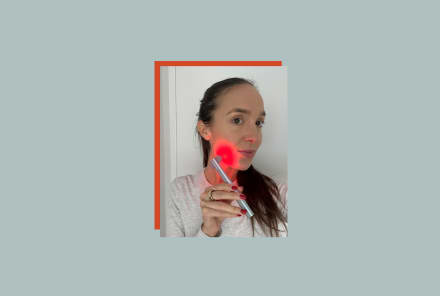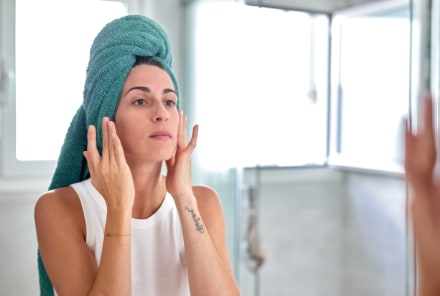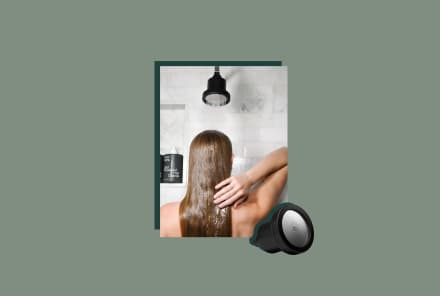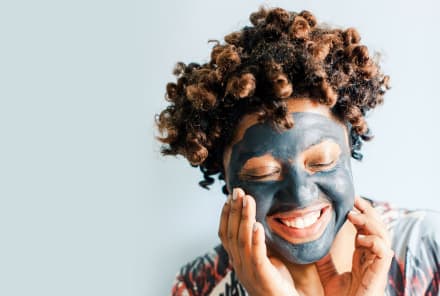Advertisement
Mole vs. Freckle: The Difference & When To Get It Checked


Chances are, all of us have a mole or freckle. And chances are also that we've all taken a quick glance in the mirror only to find a new spot on our face that wasn't there the week before. But is it a freckle or a mole? It turns out that question is harder to answer than we once thought. Both are common, and they even can look similar in appearance, but the truth is, moles and freckles are very different in nature. We tapped dermatologists to get the scoop on freckles and moles, what they are, where they come from, and how to know if they need to be examined. Keep reading to learn more.
What are moles?
"A mole is a skin growth that is comprised of pigment cells that can appear as small brown, tan, or pink spots that can be flat or raised," board-certified dermatologist and founder of Skin Wellness Dermatology in Birmingham, Alabama, Corey L. Hartman, M.D., says. These spots can be present at birth or show up as you age.
Board-certified dermatologist Tiffany Libby, M.D., says they may be round or oval-shaped, but moles can come in all different shapes and sizes. She also notes that the peak time for new moles to appear on the skin is during your 20s and 30s, but overall, the development of moles is normal.
What are freckles?
"Freckles are light to dark brown flat macules on sun-exposed skin," Hartman says. "They are often poorly defined and may merge into larger patches."
Libby agrees and says these oval-shaped brown spots occur only on sun-exposed skin and are not present at birth. "Freckles can come and go but usually start appearing as early as the first few years of life," she says. So just when you find yourself desperately wishing you had freckles all over your face, think again. These spots are caused by sun exposure and pigment transfer to the skin cells called keratinocytes. It's also important to note that freckles can only appear on the parts of the skin that get direct access to the sun.
Even though freckles are benign, they are a direct result of unprotected sun exposure. "Freckles indicate that you've had sun exposure and damage, and we know that sun exposure leads to photoaging like brown spots and wrinkles, as well as skin cancer," Libby says. "Freckles are a good reminder to wear your sunscreen and keep your skin protected as much as possible from the sun."
And yes, anyone can get freckles, no matter how light or dark your skin tone is.
Mole vs. freckle: What are the differences?
Hartman and Libby gave us a few pointers on how to distinguish the difference between a freckle and a mole. Here are a few factors to consider.
Is it raised or flat?
Deciphering whether a spot on your face is a mole or freckle can be quite the challenge, especially if the spot just seemed to appear overnight. Libby says the first test of knowing if the spot is a mole or freckle is to close your eyes and touch the area. "If the lesion is raised, it is definitely not a freckle."
What's the color?
Although moles and freckles can be a variety of hues, Hartman says even though they can be the same color, moles often appear much darker than the typical freckle. So, if you're trying to make an educated guess and the spot appears to be dark, chances are you're dealing with a mole.
Still unsure?
Libby and Hartman agree that identifying the difference between a freckle and mole can be quite the challenge for the average person. If you're still not sure and want a proper diagnosis, both experts agree you should visit your local board-certified dermatologist. "A dermatologist can examine the lesion with a special magnifying light device, called a dermatoscope," Libby says. Since 99.9% of the normal population doesn't own one of those, it's best to leave the examining up to the pros.
Signs you should get your mole or freckle checked.
While both freckles and moles are common, Libby says the key to knowing if you should get checked is to be aware of new or changing moles. She recommends using the ABCDEF's of melanoma. Check for asymmetry, border, color, and diameter changes and evolving details within your mole or freckle. Here's a handy guide from board-certified dermatologist Keira Barr, M.D.:
- Asymmetry: If the shape is not even the entire way around, get it checked. An easy tip to look out for: "If you cut a spot down the middle and the two halves don't match," says Barr.
- Border: Look to see if the outline is smooth, like an oval and round. "If a spot has uneven, scalloped, or notched edges rather than smooth," she says. If not, get it checked.
- Color: Moles are evenly colored; melanoma marks are not. "If multiple colors are present in a mole, it can be a warning sign. Benign moles are typically a single shade of brown, while melanoma may have several shades of brown, tan, black, and even red, white, or blue," she says.
- Diameter changes: If it grows, get it checked. "If a spot is larger than a pencil eraser (about 6 mm or ¼ inch in diameter) it can be a warning sign," she says. "Or any size that's larger than the other, no matter the size."
- Evolving details: Changes are always a red flag.
- Funny-looking: "Also referred to as the 'ugly duckling sign.' When you are examining your skin, you are looking for patterns in the size, shape, and color of your spots. If there is a spot that stands out like a sore thumb in your crowd, consider this your funny-looking spot to get checked," she says.
If you notice anything out of the ordinary, it's best to contact a derm, asap.
Hartman also adds that if a patient has a family history of melanoma or is red-headed, blue-eyed, or fair-skinned, any new or changing growths should be evaluated by a board-certified dermatologist.
You want to make sure you keep an eye out for this regularly, too. "I always tell people to party in your birthday suit on the date of your birthday and look for any 'uninvited guests,'" she says. "The more consistently you check your skin, the more likely you are to catch a precancerous or cancerous spot early, when it can be more readily treated. And when in doubt, make an appointment with a board-certified dermatologist."
Bottom line.
Though they look similar, freckles and moles are actually different. But since both of these spots have the ability to pop up throughout our lifetimes, it's important to monitor them and contact an expert if there are any changes or peculiar features. But the good news is, in most cases, freckles and moles are nothing to be too worried about. Just don't forget to wear your sunscreen, practice smart sun care, and give yourself a self-exam every month and a professional exam every year.
Watch Next
Enjoy some of our favorite clips from classes
Enjoy some of our favorite clips from classes
What Is Meditation?
Mindfulness/Spirituality | Light Watkins
Box Breathing
Mindfulness/Spirituality | Gwen Dittmar
What Breathwork Can Address
Mindfulness/Spirituality | Gwen Dittmar
The 8 Limbs of Yoga - What is Asana?
Yoga | Caley Alyssa
Two Standing Postures to Open Up Tight Hips
Yoga | Caley Alyssa
How Plants Can Optimize Athletic Performance
Nutrition | Rich Roll
What to Eat Before a Workout
Nutrition | Rich Roll
How Ayurveda Helps Us Navigate Modern Life
Nutrition | Sahara Rose
Messages About Love & Relationships
Love & Relationships | Esther Perel
Love Languages
Love & Relationships | Esther Perel

















